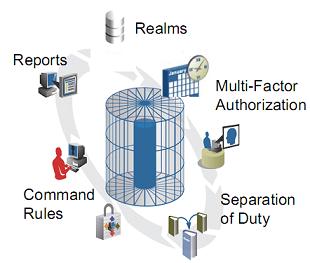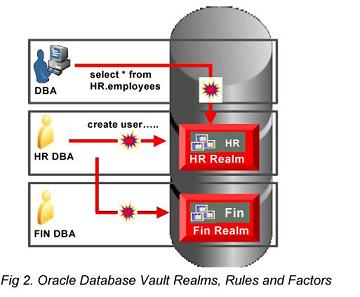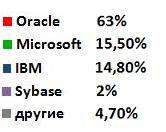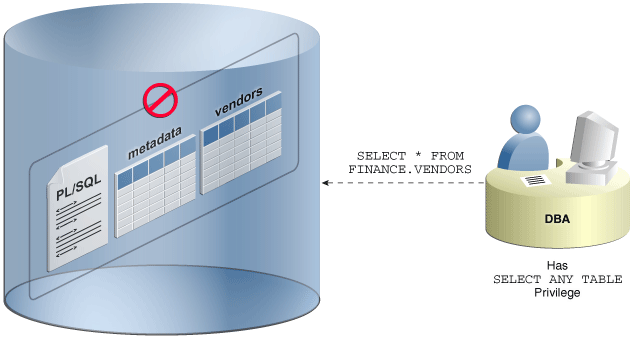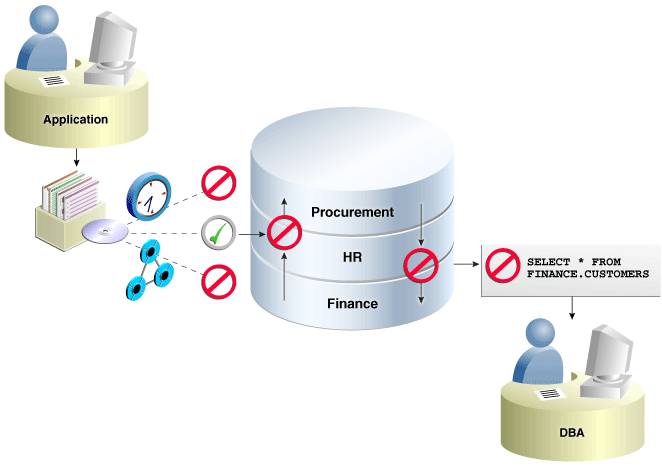oracle database vault что это
Oracle Database Vault
Oracle Database Vault обеспечивает строгий внутренний контроль соблюдения требований регулирующих органов и защиту от внутренних угроз. Oracle Database Vault не только не позволяет пользователям с широкими привилегиями просматривать конфиденциальные данные приложений, но и реализует политики доступа к приложениям, базам данным и информации в зависимости от пользователя, места и времени. Oracle Database Vault защищает приложения базы данных прозрачно для пользователя, без необходимости вносить изменения в существующие приложения.
Oracle Database Vault
Соблюдение нормативных требований по защите от внутренних угроз требует двух главных усовершенствований существующих сред:
Описанные ниже области безопасности, факторы и правила Oracle Database Vault работают в базе данных и позволяют ограничить доступ к данным приложений пользователям даже с самыми широкими полномочиями без вмешательства в ежедневную работу по администрированию базы данных. Эти функции могут использоваться гибко и адаптивно, чтобы обеспечить соблюдение требований к безопасности, не меняя существующие приложения.
Контроль над пользователями с широкими привилегиями. Должности администраторов ИТ-инфраструктуры, баз данных и приложений предполагают высокую степень доверия к людям, которые их занимают. Однако необходимость соблюдать нормативные требования, аутсорсинг, консолидация приложений и растущее беспокойство по поводу внутренних угроз привели к введению практически обязательных правил строгого контроля над доступом к конфиденциальным данным. Изменение существующего кода приложений с тем, чтобы он соответствовал новым правилам контроля, является затратным процессом, который не смогут себе позволить многие предприятия. Благодаря областям применения Oracle Database Vault предприятия могут ограничить доступ к данным приложений пользователям с широкими привилегиями, даже администраторам баз данных. Области применения можно легко и быстро задать для корпоративных приложений или наборов таблиц.
Гибкое и адаптируемое решение. Правила и факторы Oracle Database Vault существенно повышают безопасность приложений, поскольку устанавливают контроль над тем, кто, когда и где получает доступ к приложениям, базам данных и информации. Можно гибко использовать различные факторы, такие как IP-адрес и метод аутентификации, чтобы обеспечить соблюдение требований к авторизации без изменения существующих приложений. Например, доступ к базе данных можно ограничить определенным средним уровнем. Дополнительное управление способны обеспечить правила, которые можно установить для всех команд SQL.
Разделение обязанностей. Oracle Database Vault имеет мощные средства разделения обязанностей и защищает базы данных от несанкционированных изменений. По умолчанию Oracle Database Vault предлагает три четкие зоны распределения обязанностей: администрирование безопасности, управление учетными записями и управление ресурсами. Например, Oracle Database Vault не дает администратору базы данных с привилегией создания учетных записей пользователей возможности создавать новых пользователей, если у такого администратора нет соответствующей обязанности. Вы также можете распределить обязанности по администрированию ресурсов на обязанности по резервному копированию, обеспечению производительности и обновлению. По желанию обязанности можно консолидировать.
Сертификация приложений. Oracle сертифицировала Oracle Database Vault на совместимость с приложениями Oracle PeopleSoft. Легкие в использовании сценарии и пошаговые инструкции можно загрузить с ресурса Oracle Technology Network. В настоящее время идет сертификация на совместимость с приложениями E-Business Suite и Siebel, которая, как ожидается, будет завершена к концу года.
Структура российского рынка СУБД (отчет Gartner 2010)
СУБД Oracle зарекомендовала себя как решение, более простое и экономически эффективное в управлении, чем другие базы данных.
Показатели финансовой деятельности компании
Oracle database vault что это
Oracle Database Vault enables you to control administrative access to your data.
1.1 What Is Oracle Database Vault?
Oracle Database Vault provides controls to prevent unauthorized privileged users from accessing sensitive data and to prevent unauthorized database changes.
1.1.1 About Oracle Database Vault
The Oracle Database Vault security controls protect application data from unauthorized access, and comply with privacy and regulatory requirements.
You can deploy controls to block privileged account access to application data and control sensitive operations inside the database using trusted path authorization. Through the analysis of privileges and roles, you can increase the security of existing applications by using least privilege best practices. Oracle Database Vault secures existing database environments transparently, eliminating costly and time consuming application changes.
1.1.2 Controls for Privileged Accounts
Privileged database accounts are one of the most commonly used pathways for gaining access to sensitive applications data in the database.
While their broad and unrestricted access facilitates database maintenance, the same access also creates a point of attack for gaining access to large amounts of data. Oracle Database Vault realms around application schemas, sensitive tables, and stored procedures provide controls to prevent privileged accounts from being exploited by intruders and insiders to access sensitive application data.
Figure 1-1 Oracle Database Vault Realm Blocking DBA Access to Data
Description of «Figure 1-1 Oracle Database Vault Realm Blocking DBA Access to Data»
1.1.3 Controls for Database Configuration
Common audit findings are unauthorized changes to database entitlements and grants of the DBA role to too many users.
The Oracle Database Vault realms with the mandatory mode enables you to seal off access to application objects, even to those with direct object grants, including the object owner. With mandatory realms, you do not need to analyze who has access because this is clear from the list of authorized users. You can enable mandatory realms at runtime and use them in response to a cyber threat, preventing all access until the threat has been analyzed.
1.1.4 Enterprise Applications Protection Policies
Application-specific Oracle Database Vault protection policies and guidelines are available for major enterprise applications.
These enterprise applications include Oracle Fusion Applications, Oracle E-Business Suit, Oracle PeopleSoft, Oracle Siebel, Oracle Financial Services (i-Flex), Oracle Primavera, SAP, and Finacle from Infosys.
1.2 What Privileges Do You Need to Use Oracle Database Vault?
Oracle Database Vault provides database roles that enable different users to perform specific tasks, based on separation-of-duty guidelines.
The most commonly used roles are as follows:
DV_OWNER and DV_ADMIN enable you to create and manage Database Vault policies.
DV_ACCTMGR enables you to manage user accounts.
When you register Oracle Database Vault, the DV_OWNER role is granted to a user who must exist before you begin the configuration process, and the DV_ACCTMGR role is granted to a second, optional user, who must also exist before configuration. You can grant the Database Vault roles to other users, but ensure that these users are trusted.
During the registration process, you must create backup accounts for the DV_OWNER and DV_ACCTMGR users. As a best practice, Oracle strongly recommends that you keep and maintain these backup accounts.
Related Topics
1.3 Components of Oracle Database Vault
Oracle Database Vault has a set of components that include PL/SQL packages and other special tools.
1.3.1 Oracle Database Vault Access Control Components
Oracle Database Vault enables you to create a set of components to manage security for your database instance.
These components are as follows:
Realms. A realm is a protection zone inside the database where database schemas, objects, and roles can be secured. For example, you can secure a set of schemas, objects, and roles that are related to accounting, sales, or human resources. After you have secured these into a realm, you can use the realm to control the use of system and object privileges to specific accounts or roles. This enables you to provide fine-grained access controls for anyone who wants to use these schemas, objects, and roles. Configuring Realms, discusses realms in detail. See also Oracle Database Vault Realm APIs.
Factors. A factor is a named variable or attribute, such as a user location, database IP address, or session user, which Oracle Database Vault can recognize and use as a trusted path. You can use factors in rules to control activities such as authorizing database accounts to connect to the database or the execution of a specific database command to restrict the visibility and manageability of data. Each factor can have one or more identities. An identity is the actual value of a factor. A factor can have several identities depending on the factor retrieval method or its identity mapping logic. Configuring Factors, discusses factors in detail. See also Oracle Database Vault Factor APIs.
Rule sets. A rule set is a collection of one or more rules that you can associate with a realm authorization, command rule, factor assignment, or secure application role. The rule set evaluates to true or false based on the evaluation of each rule it contains and the evaluation type (All True or Any True). The rule within a rule set is a PL/SQL expression that evaluates to true or false. You can have the same rule in multiple rule sets. Configuring Rule Sets, discusses rule sets in detail. See also Oracle Database Vault Rule Set APIs.
Secure application roles. A secure application role is a special Oracle Database role that can be enabled based on the evaluation of an Oracle Database Vault rule set. Configuring Secure Application Roles for Oracle Database Vault, discusses secure application roles in detail. See also Oracle Database Vault Secure Application Role APIs.
To augment these components, Oracle Database Vault provides a set of PL/SQL interfaces and packages. Oracle Database Vault PL/SQL Interfaces and Packages provides an overview.
In general, the first step you take is to create a realm composed of the database schemas or database objects that you want to secure. You can further secure the realm by creating rules, command rules, factors, identities, rule sets, and secure application roles. In addition, you can run reports on the activities these components monitor and protect. Getting Started with Oracle Database Vault, provides a simple tutorial that will familiarize you with basic Oracle Database Vault functionality. Later chapters provide more advanced tutorials. Oracle Database Vault Reports, provides more information about how you can run reports to check the configuration and other activities that Oracle Database Vault performs.
1.3.2 Oracle Enterprise Manager Cloud Control Database Vault Administrator Pages
Oracle Database Vault is pre-installed by default and can be enabled easily.
Oracle Database Vault administration is fully integrated with Oracle Enterprise Manager Cloud Control, providing security administrators with a streamlined and centralized interface to manage Oracle Database Vault.
In Oracle Enterprise Manager Cloud Control, you can access the Oracle Database Vault Administrator pages if you prefer to use a graphical user interface to configure Database Vault policies, and view Database Vault alerts and reports. Oracle Database Vault Administrator provides an extensive collection of security-related reports that assist in understanding the baseline security configuration. These reports also help point out deviations from this baseline.
Getting Started with Oracle Database Vault through DBA Operations in an Oracle Database Vault Environment explain how to use the Oracle Database Vault Administrator pages to configure access control policy defined in realms, command rules, factors, rule sets, secure application roles, and how to integrate Oracle Database Vault with other Oracle products. Monitoring Oracle Database Vault explains how to use these pages to monitor Database Vault activity, and Oracle Database Vault Reports, explains Oracle Database Vault reporting.
1.3.3 Oracle Database Vault DVSYS and DVF Schemas
Oracle Database Vault database objects and public functions are stored in the DVSYS and DVF schemas, respectively.
Related Topics
1.3.4 Oracle Database Vault PL/SQL Interfaces and Packages
Oracle Database Vault provides PL/SQL interfaces and packages for security managers or application developers to configure access control policies.
The PL/SQL procedures and functions allow the general database account to operate within the boundaries of access control policy in the context of a given database session.
1.3.5 Oracle Database Vault Reporting and Monitoring Tools
You can generate reports on the various activities that Oracle Database Vault monitors.
In addition, you can monitor policy changes, security violation attempts, and database configuration and structural changes.
Related Topics
1.4 How Oracle Database Vault Addresses Compliance Regulations
One of the biggest side benefits resulting from regulatory compliance has been security awareness.
Historically, the focus of the information technology (IT) department has been on high availability and performance. The focus on regulatory compliance has required everyone to take a step back and look at their IT infrastructure, databases, and applications from a security angle. Common questions include:
Where is the sensitive information stored?
Who has access to this information?
Regulations such as the Sarbanes-Oxley Act, Health Insurance Portability and Accountability Act (HIPAA), International Convergence of Capital Measurement and Capital Standards: a Revised Framework (Basel II), Japan Privacy Law, Payment Card Industry Data Security Standard (PCI DSS), and the European Union Directive on Privacy and Electronic Communications have common themes that include internal controls, separation of duty, and access control.
While most changes required by regulations such as Sarbanes-Oxley and HIPAA are procedural in nature, the remainder may require technology investments. A common security requirement found in regulations is stringent internal controls. The degree to which Oracle Database Vault helps an organization achieve compliance varies with the regulation. In general, Oracle Database Vault realms, command rules, factors and separation of duty features, help reduce the overall security risks that regulation provisions worldwide address.
Table 1-1 lists regulations that address potential security threats.
Table 1-1 Regulations That Address Potential Security Threats



